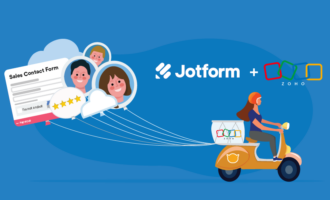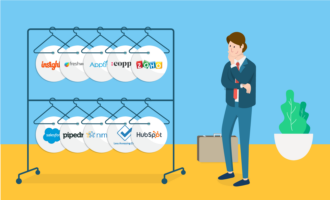Your CRM is only as powerful as the prospect and customer information and data that’s in it.
In order to scale, your CRM needs to communicate with other key aspects of your business. This is what integrations — or connectors — do.
By automating and improving your existing systems and processes, integrations help your team be more productive when using your CRM, and they eliminate knowledge and/or team silos.
From email and Slack to phone support, feature requests, and contracts, we’re sharing 10 must-have CRM integrations you can use to sync critical functions and optimize your business.
Here are 10 must-have CRM integrations
Email
Slack
- Quickly reference CRM contact or account details through a search in Slack.
- Automatically send new deals won into a Slack channel to boost your sales team’s morale.
- Send follow-up notifications and reminders.
- Reply to new messages without leaving Slack.
Social media
Contracts
Phone support
- Setting up click-to-call
- Doing warm transfers to reps in other departments, such as billing or sales
- Saving interaction logs and tying them to a specific customer’s account
Live chat support
Feature requests and bug tracking
Project management
Signup or contact forms
Zapier
- Sync Hubspot CRM details with Wave billing or invoice details.
- Sync Hubspot CRM with Facebook Lead Ads.
- Sync their CRM with new Eventbrite attendees.
Whether you use Salesforce, HubSpot, Pipedrive, or another CRM, make sure that it integrates with your email and calendar. Most CRMs have standard integrations with Google apps, Outlook, and Office365.
These integrations allow you to assign emails to specific accounts or contacts, schedule meetings within your CRM, and keep track of sales deals.
When you sync your CRM with Slack, you can increase your team’s collaboration and productivity.
Here are some common use cases:
People do business with those they know, like, and trust. This can help you pre- and post-sale. For starters, integrating social media data into your CRM can help you learn more about prospects without leaving your main CRM dashboard.
You can also monitor and reply to any customers who ask questions on social media from within your CRM.
Another use case is integrating your contract, proposal, and legal documentation software, such as PandaDoc, DocuSign, etc., directly with your CRM. This allows you to create contracts within your CRM and attach signed agreements to specific accounts.
Your support staff needs to be able to access customer details on phone calls quickly. Syncing a phone system such as Five9 with your CRM can help you solve problems. Some common use cases include
If you have live chat on your site for sales, support, or both, it’s essential to sync this with your CRM. This will not only allow chat agents to verify contact information and access key details quickly but also to save chat logs to specific accounts.
When you chat with prospects and customers, they may suggest new feature ideas or report bugs. You can automatically tie these requests to your product roadmap or bug tracking software. This allows your product and engineering teams to prioritize requests quickly, see how many people have requested a specific feature, and track bugs.
When you integrate project management software like Trello, Asana, Teamwork, or Basecamp with your CRM, you can quickly track projects and automate workflows.
For example, if you’re launching a big sales campaign for a new product line, you can sync your tasks, access relevant documents, and track your progress right from your CRM.
Another use case is to sync your contact forms with your CRM. This can include everything from sales inquiries to customer support requests.
Pro tip: Did you know that Jotform integrates with many CRMs, including Salesforce, HubSpot, and Pipedrive? So if a lead fills out the contact form on your website, the info is automatically sent to your CRM, where you can reply.
Zapier is like the duct tape of the internet, enabling you to connect hundreds of software tools to your CRM based on your specific needs.
Here are a few use cases for how people use Zapier to connect their CRM with other tools they use:
When your CRM acts as the single source of truth in your organization, it’s paramount that the data in it is accurate. Taking the time to set up these integrations can not only ensure up-to-date information but also help you streamline the business.


















































Send Comment:
2 Comments:
More than a year ago
Basically, CRM integration is building your site and CRM to work together flawlessly. Rather than utilizing your CRM to simply be a framework that holds client data dependent on manual passages, incorporating your site/showcasing robotization programming acquires significant client data straightforwardly into your CRM.
More than a year ago
Thanks for this post.
I really enjoy your point of view on the "top 10 CRM integrations to optimize your business".
In this article, you included 10 must-have CRM integrations. You are right, but the numbering order is wrong. Please correct your mistake.
Once again it is really nice article.